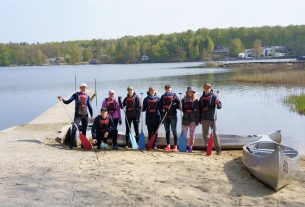LOCATION
Greifswald – a city in Mecklenburg-Western Pomerania, approx. 60 km from Barth, 37 km from Stralsund, 30 from Wolgast and 165 km from Szczecin. The city is located on the Ryck River near the estuary to the Baltic Sea. There is a marina here, so you can get here not only by car or by train but also by yacht. 54°06′N 13°23′E


photo source:
SCENIC CHARACTER
The name of the city of Greifswald comes from the griffin, which is the coat of arms of the ducal Griffins dynasty. The city was founded in 1199, when the Cistercians founded the Eldena monastery. Although today only ruins are left, it is worth a visit it and to know the history of the place. You find information, that some of Griffins dynasty was buried in this place, among them Anna Jagiellonka, called the Mother of the Dukes of Griffins, the wife of Bogusław X and the daughter of the King of Poland. In 1250 the city received town rights from the Duke of Warcisław III. In 1456, the oldest university in Pomerania was established in this city. In front of the University building, there is a monument called the Rubenow Monument, illustrating the history of the University. Among the figures, there is Duke Warcisław IX co-founder of the University and Duke Bogusław XIV, who, aware of the end of the dynasty, gave the university several villages and the property of the former Cistercian monastery in Edena. This provided the university with over two hundred years of financial independence. After the expiration of the dynasty, Duke Ernest Bogusław de Croy gave the University, among others Rectory insignia used today, which are kept at the local Pommersches Landesmuseum. The most valuable exhibit in the Museum is Gobelin Croya – woven with gold, silver and silk (height 454 cm, width 686 cm) the tapestry is a kind of political and ideological declaration of the Griffins. It shows of Pomeranian and Saxon dukes as well as famous reformers: Marcin Luther, Filip Melanchthon and Jan Bugenhagen. Der Croy-Teppich, obtained in 2014 in Germany the status of a national cultural treasure. An excellent copy of the tapestry can be found in the National Museum in Szczecin at the exhibition The Golden Age of Pomerania.
ATTRACTIONS
A nice place for tourists in Greifswald is the urban square surrounded by houses in the Hanseatic style and the Town Hall. It is also worth visiting the gothic red brick churches characteristic of Pomerania: Cathedral of St. Nicolaus, Church of St. James and St. Mary’s Church. The city there is on the Route of Brick Gothic, the Hanseatic Route and the Way of St. James. Above the river is a historic wooden drawbridge, and near the cutters and restaurants, where you can eat fresh fish. During a walk around the city, visit the Caspar David Friedrich Museum, one of the greatest representatives of Romantic painting. In his paintings, we can also find the ruins of the monastery Eldena.
INFORMATION SOURCES
Heritage Class: [ C ]Cultural Heritage
Subclass [MS] : Monuments and sites
WEB PAGES






